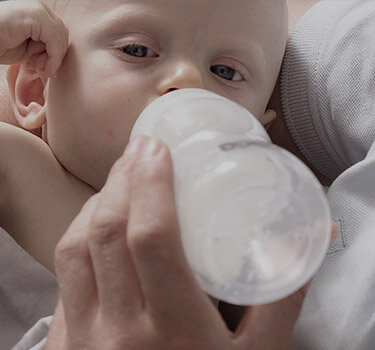Breastfeeding can be difficult at the beginning. It's not that easy to “just breastfeed”. Read our article to find out what are the most common breastfeeding problems and how to overcome them.
Expert consultant: Katarzyna Orawiec-Rymszewicz – midwife, lactation educator
Are you breastfeeding? Have you just experienced your first crisis? Sore nipples, breast engorgement or lack of milk? You probably wonder, how to solve those problems. Follow our advice and breastfeed without stress.
While starting your lactation adventure, you may worry that your baby is not getting enough milk. But most likely, you shouldn’t. Your breasts will produce just a little milk at the beginning, and with time your lactation will slowly kick in. Moreover, your little one's stomach is still very small. After birth, it can hold no more than 5-10 ml of milk. Just feed your baby regularly, eat well and drink plenty. You can also stimulate your lactation with help of a breast pump.
New mums also tend to believe that they are making not enough milk, even though their babies are full. This is quite normal. Perception of low milk supply is a very common problem. Before you start worrying, check whether there are any medical reasons for the low milk supply. A mum with anaemia, polycystic ovarian syndrome or disturbed hormonal regulation indeed can produce less milk. If your baby has signs of dehydration and they are losing weight, see a lactation consultant. Maybe the blame is on the ineffective breastfeeding technique.
Breast engorgement is a normal physiological process occurring between the 2nd and 6th day after birth. The breasts are heavy and swollen, overfilled with too much milk. You can ease the discomfort by:
breastfeeding often,
applying cold compresses,
expressing small amounts of milk using a breast pump,
ensuring proper breastfeeding position.
Breast engorgement is a sign that your lactation is successful, so don't worry if it occurs. If the pain intensifies, contact a lactation specialist. Incorrect management of breast engorgements, such as skipping or delaying feedings, incorrect positioning or even a poor-fitting or too-tight bra can lead to milk stasis.
Blocked milk ducts can cause milk stasis. Symptoms of milk stasis are discomfort and pain. The breast is sore and swollen and the milk does not flow properly. Milk stasis usually affects only one breast. Remember to always start feedings from the affected breast. Before feeding, express a little milk by hand to soften the areola and make it easier for your baby to grasp the nipple. After and between feedings apply cold compresses to the affected breast. If the problem doesn’t go away, see the specialist.
Sore nipples are a common breastfeeding problem. It can be caused by mastitis or anatomical abnormalities, such as flat or concave nipples. Sore nipples usually happen because of an incorrect breastfeeding position. To tackle the issue:
Seek advice on breastfeeding positioning and attachment.
Start feeding from the breast, which hurts less. Your baby will satisfy their first hunger and when attached to the other breast, they will eat calmer and suckle more gently.
Feed your baby often and regularly so that your breasts don't get overly full.
Learn the right breastfeeding technique and change positions during breastfeeding.
Nipple pain during breastfeeding is often a physiological response. It appears during the first week of breastfeeding and goes away as the breasts get used to the suction after about 6 weeks.
If your nipple hurts, is red and your breasts sting when you finish feeding, plus you have headaches, joint pain and a fever, you are probably struggling with mastitis. Contact a specialist who will prescribe antibiotics.
Cracked nipples are a common consequence of poor breastfeeding technique. You can treat cracked nipples by applying freshly expressed milk, using special moisturising creams, applying compresses and exposing nipples to air as often as possible. If the crack is quite big, use nipple shields during feedings. Remember to measure your nipples to get shields in the right size.
Technically, a term "latching on" is a very precise one, as actually you do not give a breast to the baby, but "attach" the baby to your breast.
Your baby has been in this world for a few hours, the first unforgettable moments of kangaroo care are over, or you can finally be together after a forced separation - the time has come for the first latching on to a breast for feeding. Remember, your baby still does not need large amounts of milk, as its stomach is very tiny.
The first comfortable feeding position is selected depending on the mum's condition.
The woman lies on her side, with her head resting on pillows. The baby is facing its mum, in a tummy-to-tummy position, his head rests in the crook of the mum's elbow, and her forearm supports the baby's back.
When you find it difficult to lie on your side, or cannot roll over after a C-section and must lie on your back. In these situations, a lying position on your back will be helpful, with the baby placed along or across your belly. The baby is placed on you, with his head on your breast, and you support him by embracing him with your hand to keep him stable. When you find it difficult to move to place the baby correctly in this position, ask a midwife for help.
Sit comfortably in an armchair or on a sofa, with your back straight and supported. You should hold your baby with his head in the crook of your elbow, supporting his bottom with your hand, with the baby's tummy touching your belly.
In this position you can easily maneuverer the baby's head, so feed in this position whenever you can, when you start to learn how to breastfeed or when the baby grasps the breast incorrectly in other positions. Sit comfortably with your back straight. Place a rolled pillow on the side of the breast you are going to give to the baby. Place your hand under the baby's head and neck, and your forearm under his back, so the baby is turned to you with his tummy, and his legs are under your arm. Put the baby onto your breast, ensuring his head and back form a straight line.
Once again: you can learn how to correctly latch your baby on, as it is a matter of your technique and not your instinct. Below there is a step-by-step instruction, emphasizing the points you need to pay attention to:
Take the breast in your hand, supporting it with four fingers from underneath, and the thumb above the nipple. Your fingers should be outside the areola.
Encourage the baby to open his mouth wide, by delicately touching his lips with the nipple. Then he should open his mouth wide and move his head, seeking food.
When the baby opens his mouth, direct the baby's head, with his open mouth aiming at the breast (not the other way round).
When the baby grasps the breast correctly:
whole nipple with the areola is in his mouth;
tip of the baby's nose and his chin touch the breast in a perpendicular position;
both baby's lips are turned out;
his cheeks are full and rounded, not sucked in during suckling;
baby's tongue is under your nipple, and you can feel it pulling the nipple from the bottom, with scooping movements.
You can hear the baby swallowing milk.
You can notice changing suckling pattern. At the beginning, the baby sucks quickly and shallowly, and then slowly, strongly, and rhythmically.
Breastfeeding should not hurt. However, you can feel a tingling sensation in your breasts, related to the oxytocin spasm supporting milk letdown.
When you have to stop feeding for any reasons (you feel pain, you must do something, the baby has fallen asleep with your breast in his mouth), insert your little finger delicately into the corner of the baby's mouth, press the breast delicately to remove air, and take the nipple out.
You are expecting a baby and want to breastfeed, or maybe you have already started this exceptional adventure, but your head is full of questions and doubts, as in many cases it is not an easy and problem-free task. We will ...
Can I breastfeed after a C-section? Will I have milk? Will my baby know how to suck?" These questions often trouble future mothers with an elective C-section. We would like to convince you that a C-section is not an obstacle ...
A popular opinion says that breastfeeding is a great sacrifice on a woman's part for a baby's good. The truth is this way of feeding is advantageous not only to the baby but also to the breastfeeding mum.
Many mums worry whether their breasts produce enough milk. The doubts usually occur when a child often cries, demands breast more frequently than usual, breasts become soft and you do not need breast pads anymore. However, ...
Breastfeeding is a wonderful gift that nature gave to women. A gift both for the child and for mothers themselves. Explore the benefits of breastfeeding.
To achieve successful beginnings of breastfeeding, you will need self-confidence, patience, support from the loved ones and getting acquainted with a handful of tips that will allay fears and doubts.
What is the difference between colostrum and the proper milk? How to latch? We ask ourselves these questions at the beginning of feeding. Here you will find the answers.
Although many mums worry about it, breastfeeding does not make breasts unattractive. Just take care of them properly choosing the appropriate underwear, cosmetics and products for lactation hygiene.
During feeding the baby sometimes swallows air that accumulates in the digestive tract and can cause colic, bloating and posseting. Therefore, after each feeding you should encourage your child to burp. We show 3 burping ...
The initial failure of breastfeeding may be associated with sore, inverted or flat nipples. Explore solutions to help yourself overcome these problems.

